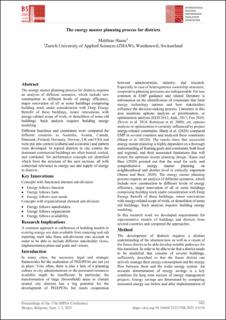Bitte benutzen Sie diese Kennung, um auf die Ressource zu verweisen:
https://doi.org/10.21256/zhaw-24338| Publikationstyp: | Konferenz: Paper |
| Art der Begutachtung: | Peer review (Publikation) |
| Titel: | The energy master planning process for districts |
| Autor/-in: | Haase, Matthias |
| et. al: | No |
| DOI: | 10.26868/25222708.2021.31154 10.21256/zhaw-24338 |
| Tagungsband: | Proceedings of Building Simulation Conference 2021 |
| Seite(n): | 684 |
| Seiten bis: | 682 |
| Angaben zur Konferenz: | 17th International IBPSA Building Simulation Conference, Bruges, Belgium, 1-3 September 2021 |
| Erscheinungsdatum: | 2021 |
| Verlag / Hrsg. Institution: | International Building Performance Simulation Association |
| ISSN: | 2522-2708 |
| Sprache: | Englisch |
| Schlagwörter: | Energy master planning; Neighborhood level; District model |
| Fachgebiet (DDC): | 333.79: Energie |
| Zusammenfassung: | AIM AND APPROACH: The energy master planning process for districts requires an analysis of different scenarios, which include new construction to different levels of energy efficiency, major renovation of all or some buildings comprising building stock under consideration with Deep Energy Retrofit of these buildings, minor renovations with energy-related scope of work, or demolition of some old buildings. Such analysis requires building energy modeling. In this research work we collected models of representative buildings from several countries and compared them. SCIENTIFIC INNOVATION AND RELEVANCE: Complex districts consist of buildings and outdoor spaces with specific needs. The use that different buildings and areas are put to affects energy consumption, whereas the different functional patterns and stakeholder groups influence energy use. They are also associated with specific requirements that make it relevant to consider different types of performance indicators. In the scope of this analysis both ventilation indicators and requirements with a direct or an indirect effect on energy consumption in districts are identified. When defining the relevance of performance indicators; legal requirements (i.e. for work environment), ownership or authority over parts of the district (single buildings or a complex of buildings), and cultural context also come into play. PRELIMINARY RESULTS AND CONCLUSIONS: Energy can be considered to follow function because energy in the end is used to meet requirements defined by the activities that take place in a district. In each district, requirements are diversified by the type of activities/functions (residences, commercial (shops, retail), service (schools, restaurants, cafes, etc.), by the sizes of tenants rental spaces, or by the type of spaces (public areas, offices, parking etc.). The different activities can be characterized by functional patterns for various groups; – opening hours for commercial buildings will differ from operational hours for technical services and lighting. Facility operation has to meet the requirements of staff in commercial and cultural or service buildings before they open to the public. In districts, many tasks are performed outside of opening hours which require maintaining health and safety for the workers. Examples are maintenance and cleaning, sanitation and supply infrastructures, mobility and transport. In relation to this, the ratio of full operation of HVAC and lighting vs. opening hours or service hours is one index that could be used as a performance indicator. |
| Weitere Angaben: | Paper ID 31154 |
| URI: | https://digitalcollection.zhaw.ch/handle/11475/24338 |
| Volltext Version: | Publizierte Version |
| Lizenz (gemäss Verlagsvertrag): | Lizenz gemäss Verlagsvertrag |
| Departement: | Life Sciences und Facility Management |
| Organisationseinheit: | Institut für Facility Management (IFM) |
| Enthalten in den Sammlungen: | Publikationen Life Sciences und Facility Management |
Dateien zu dieser Ressource:
| Datei | Beschreibung | Größe | Format | |
|---|---|---|---|---|
| 2021_Haase_Energy-master-planning-process-for-districts_BS2021.pdf | 1.98 MB | Adobe PDF |  Öffnen/Anzeigen |
Zur Langanzeige
Haase, M. (2021). The energy master planning process for districts [Conference paper]. Proceedings of Building Simulation Conference 2021, 684–682. https://doi.org/10.26868/25222708.2021.31154
Haase, M. (2021) ‘The energy master planning process for districts’, in Proceedings of Building Simulation Conference 2021. International Building Performance Simulation Association, pp. 684–682. Available at: https://doi.org/10.26868/25222708.2021.31154.
M. Haase, “The energy master planning process for districts,” in Proceedings of Building Simulation Conference 2021, 2021, pp. 684–682. doi: 10.26868/25222708.2021.31154.
HAASE, Matthias, 2021. The energy master planning process for districts. In: Proceedings of Building Simulation Conference 2021. Conference paper. International Building Performance Simulation Association. 2021. S. 684–682
Haase, Matthias. 2021. “The Energy Master Planning Process for Districts.” Conference paper. In Proceedings of Building Simulation Conference 2021, 684–82. International Building Performance Simulation Association. https://doi.org/10.26868/25222708.2021.31154.
Haase, Matthias. “The Energy Master Planning Process for Districts.” Proceedings of Building Simulation Conference 2021, International Building Performance Simulation Association, 2021, pp. 684–82, https://doi.org/10.26868/25222708.2021.31154.
Alle Ressourcen in diesem Repository sind urheberrechtlich geschützt, soweit nicht anderweitig angezeigt.